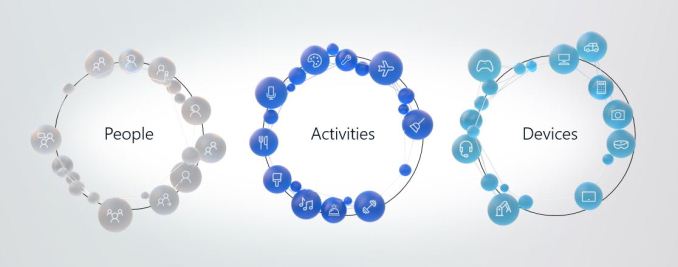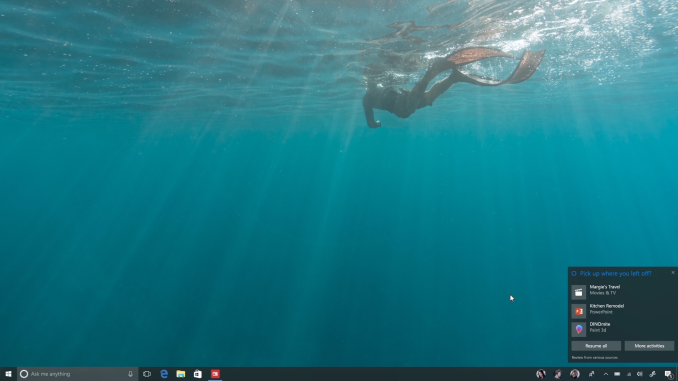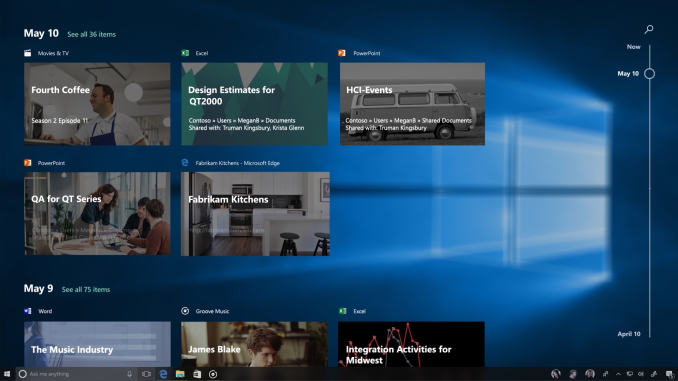The Microsoft Build 2017 Recap: What To Expect When You’re Expecting Windows
by Brett Howse on May 19, 2017 8:00 AM ESTCortana and Microsoft Graph
It would have been easy to write off Cortana when it was first announced. After all, it was just another personal assistant, and we’d already seen that done a few times. But Cortana is Microsoft’s real link into ecosystems that are not their own, and having that presence across devices that are not running Windows is possibly one of the most important ways they can maintain that presence as the device engagement on Windows goes down. Microsoft is now connecting Windows to the Microsoft Graph, which is going to open up a lot more capabilities for developers, as well as some great features for users. If you’re not a fan of cloud connected devices, this probably isn’t for you, but some of the capabilities are very appealing.
Clipboard
The ability to copy and paste between devices is something that iOS and macOS users have enjoyed for some time, and now Microsoft is brining it to Windows with the ability to copy and paste “just about anything” between your PC and your phone, whether or not it is iOS or Android. That should be very well received.
Pick up where you left off
This is an interesting idea, but going to be more limited in apps that can be used, but if you log off your PC, Cortana on your phone will ask if you want to keep editing the document you were on, as an example, or maybe it’s the website you were browsing on your phone that you want to pick up on your PC. As long as this doesn’t become a bother, it could be pretty handy when you need to switch devices.
Timeline
This is a very interesting use of the Microsoft Graph. With Timeline, you can go back to a visual timeline of things you were doing before, so it should be much easier to get back to a task that you hadn’t completed, or if you ever have that “what was I just working on?” moment. With File History, we can already go back to files we need to get back, but this is a backup for ideas. Very clever.
The key is Cortana, which is Microsoft’s link to other platforms. Ideas like this may encourage people to use Cortana more on their non-Windows devices, but without user buy-in, this could be an interesting set of features that don’t get much traction. The other issue is Cortana availability, which is very USA first, as with most Microsoft projects. If they want this to succeed, they need to make sure their global audience can use it, but that’s never seemed to be a priority before.
The Microsoft Graph could end up being one of the most important pieces from Microsoft, but first it needs to ship, and then it needs to work well, so for now, let’s reserve judgement.













85 Comments
View All Comments
Kevin G - Tuesday, May 23, 2017 - link
Not sure that is true anymore (it certainly was in the past). This have changed with 10 bit and HDR becoming consumer technologies now.CSMR - Saturday, May 20, 2017 - link
"Windows has never had a color management system to speak of"The current color management system dates back to Windows Vista and Microsoft imaging applications did a good job, with some exceptions including Internet Explorer/Edge. Win10 even does a reasonable job by default, with default monitor profiles loaded automatically.
Brett Howse - Saturday, May 20, 2017 - link
It's hard to give Windows credit for color management when all of the burden is put on the developer to do all the work. That's the case right now with wide color and HDR too but doesn't appear to be the long term goal.ironwing - Sunday, May 21, 2017 - link
"Possibly some of the biggest news about Windows actually got announced on April 20, when Microsoft committed to biannual updates for their operating system."Should be "semiannual".
Brett Howse - Sunday, May 21, 2017 - link
Definition of semi-annual: occurring every six months or twice a year
Definition of biannual
: occurring twice a year
ironwing - Sunday, May 21, 2017 - link
Oops, I was reading biennial. My bad, carry on.sorten - Sunday, May 21, 2017 - link
When I saw the Google IO live coverage I was wondering if you were going to mention Build from the previous week.zepi - Monday, May 22, 2017 - link
I think one remaining issue with using Windows is the complexity of licensing in business use. Buying individual license for personal usage is simple enough, but licensing models for server versions are still a dark art.If I were a manager making decision on whether we should use Windows or Linux as a OS under our application platform, I'd be worried that costs are very opaque and I have hard time understanding the licensing. Now, obviously one doesn't just do a decision like that and .net being open sourced and usable on linux these caveats have reduced somewhat, but the underlying issue is still there.
I suppose MS thinks that azure solves this by providing a simple monthly rolling cost that abstracts everything into a one monthly bill...
doggface - Monday, May 22, 2017 - link
You are forgetting enterprise.The thing windows does very well is scale. For example, If you want to deploy an app to 5000 PCs you can click a few buttons and it is done.
If you want to block behaviour, you can do it using GPOs.
No other platform has that control.
doggface - Monday, May 22, 2017 - link
I think we can all agree you have control issues.